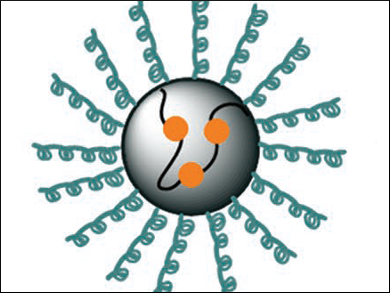Light-controlled drug release at the site of a tumor is of great interest for cancer treatment since these systems can prevent the characteristic toxic effects of anticancer drugs to healthy cells during chemotherapy.
Dongfang Zhou, Chinese Academy of Science, Changchun, China, and colleagues have constructed photo-cleavable prodrug-backboned copolymer micelles. The team used Pt(IV) complexes not only as an anticancer prodrug, but also as a stimuli-responsive group.
The copolymer consists of a triblock structure, with poly(ethylene glycol) (PEG) on each end and a middle part of hydrophobic polyurethane (PU) with repeating photo-cleavable Pt(IV)-azide prodrug complexes. The central PU-Pt(N3) part is prepared by a step-growth polymerization of trans,trans,trans-[Pt(N3)2(OH)2(py)2] (py = pyridyl) and subsequently connected with PEG to yield the triblock copolymer PEG-PUPt(N3)-PEG.
The copolymer forms biocompatible spherical micelles (pictured) in aqueous solutions. Irradiation with light leads to photo-cleavage of the PUPt(N3) block and photo-activation of the Pt(IV) complex. This results in disintegration of the copolymer micelles and the active Pt(II) anticancer drug is released. A study in mice shows a lower cytotoxic effect compared to the chemotherapy agent cisplatin.
- Simultaneously Photo-Cleavable and Activatable Prodrug-Backboned Block Copolymer Micelles for Precise Anticancer Drug Delivery,
Dongfang Zhou, Jinshan Guo, Gloria B. Kim, Jizhen Li, Xuesi Chen, Jian Yang, Yubin Huang,
Adv. Healthcare Mater. 2016.
DOI: 10.1002/adhm.201600470




